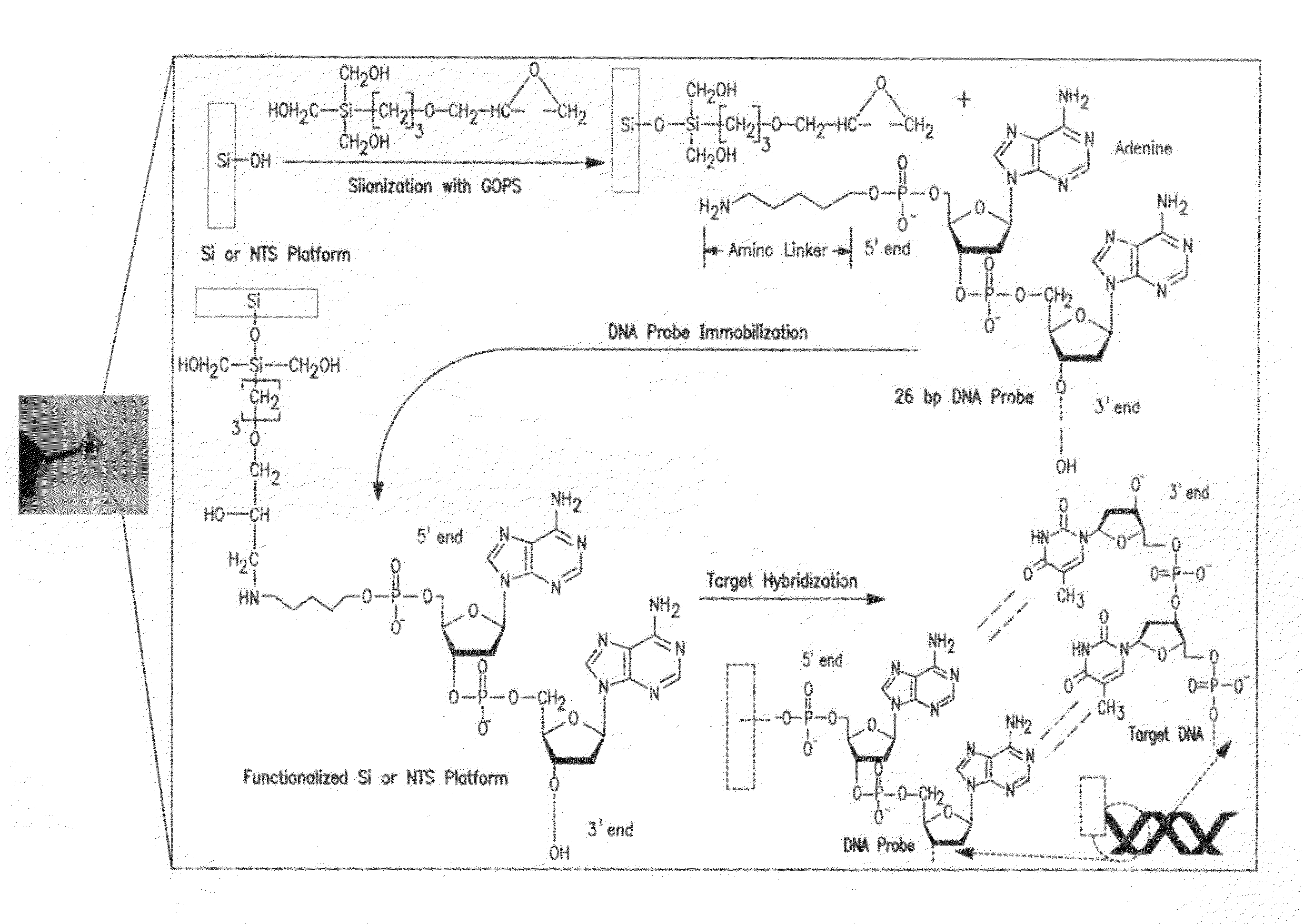Nanoporous silicon-based electrochemical nucleic acid biosensor
a biosensor and nanoporous silicon technology, applied in the field of nanoporous silicon based electrochemical nucleic acid biosensors, can solve the problems of time-consuming and laborious process
- Summary
- Abstract
- Description
- Claims
- Application Information
AI Technical Summary
Benefits of technology
Problems solved by technology
Method used
Image
Examples
example 1
[0078]Nanoporous Silicon (NPS) Characterization: The porosity and thickness of the nanoporous silicon (NPS) obtained using anodization conditions of 5 mA / cm2 for 1 h with 15% ethanoic solution of HF was determined gravimetrically (Table 1). The percent porosity of the NPS ranged from 70.00% (Chip 10) to 87.23% (Chip 4), and the thickness of the NPS layer varied from 13.09 μm (Chip 3) to 21.67 μm (Chip 1). The mean percent porosity of the NPS layer for the 14 chips was 80.21%±4.29% with a corresponding mean thickness of 17.54 μm±2.82 μm. The percent porosity of the NPS was similar to that reported previously under similar anodizing conditions (Amato, G., Boarino, L., Borini, S., Rossi, A. M., 2000. Hybrid approach to porous silicon integrated waveguides. Phys. Status Solidi A-Appl. Res. 182(1), 425-430; Halimaoui, A., 1997. Porous silicon formation by anodization. In: Canham, L. (Ed.), Properties of porous silicon. INSPEC, The Institution of Electrical Engineers, London, UK, pp. 12-1...
example 2
[0103]It is to be understood that the biosensor device of the present invention can be used to specifically detect any target nucleic acid of interest. U.S. Pat. Nos. 5,527,669 and 5,580,718 to Resnick et al.; 5,919,638 to Russell et al.; 6,277,968 to Sun et al.; 6,518,416, 6,573,052 and 6,582,919 to Danenberg; 6,881,537 to Goudsmit et al.; 6,949,342 to Golub et al.; 7,078,516 to Moncany et al.; 7,108,969 to Warrington et al.; 7,115,364 to Chee et al., are each hereby incorporated herein by reference in their entirety. These patents disclose some examples of nucleic acids, such as oligonucleotides, that can be used as the DNA probe in the present invention. The DNA probe can be designed so that it hybridizes to any known target nucleic acid of interest. In some embodiments, the sensitivity of detection of a DNA molecule or RNA molecule can be further increased by first performing a polymerase chain reaction (PCR) procedure in the case of a DNA molecule, or a reverse-transcription po...
example 3
[0105]Another embodiment is a method of detection of hepatitis C virus (HCV) is performed by a procedure modified from U.S. Pat. Nos. 5,527,669 and 5,580,718 to Resnick et al. A sample obtained from a human patient is first used to perform a reverse transcription reaction to provide a cDNA that is used in a PCR procedure to provide an amplified product. Next, a biosensor device of the present invention, having a DNA probe having a nucleotide sequence of an oligonucleotide described by Resnick et al., can be used to quickly check the specificity of the amplification band. Detection by the biosensor device of the target nucleic acid of interest can be used by a physician to make a diagnosis of infection by the HCV virus.
PUM
| Property | Measurement | Unit |
|---|---|---|
| Electrical resistance | aaaaa | aaaaa |
| Capacitance | aaaaa | aaaaa |
Abstract
Description
Claims
Application Information
 Login to View More
Login to View More - R&D
- Intellectual Property
- Life Sciences
- Materials
- Tech Scout
- Unparalleled Data Quality
- Higher Quality Content
- 60% Fewer Hallucinations
Browse by: Latest US Patents, China's latest patents, Technical Efficacy Thesaurus, Application Domain, Technology Topic, Popular Technical Reports.
© 2025 PatSnap. All rights reserved.Legal|Privacy policy|Modern Slavery Act Transparency Statement|Sitemap|About US| Contact US: help@patsnap.com



